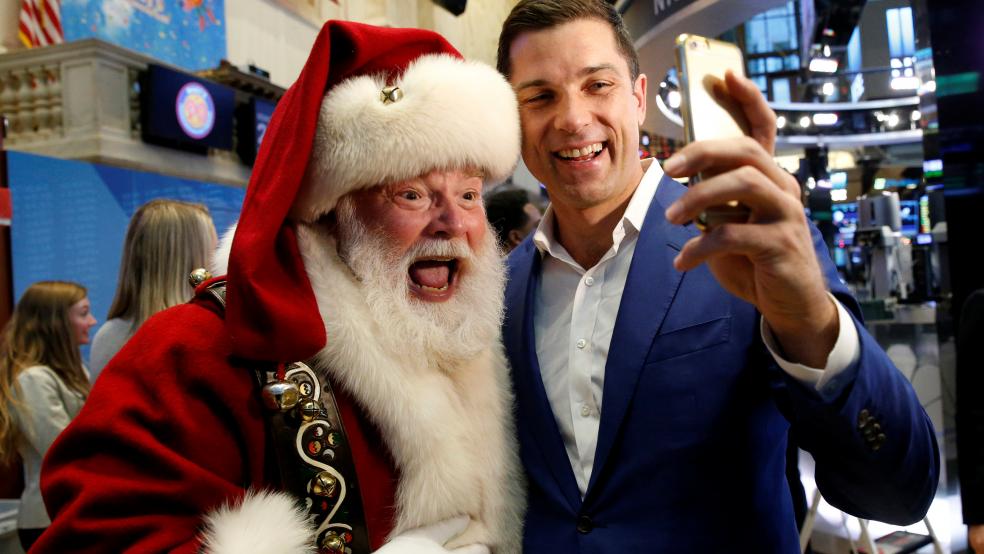The rip-your-face-off stock market rally may have cooled, but the Dow Jones Industrial Average is still above 19,000 and the S&P 500 is holding above 2,200. It's almost scary, in a way, to see Wall Street surge on the surprise victory of president-elect Donald Trump — an event, the naysayers warned, that would usher in the financial apocalypse.
The opposite has happened over the last three weeks as years of cheap-money incrementalism and political gridlock have given way to genuine excitement about a possible avalanche of fiscal stimulus from Trump and the Republicans in Congress. This is more or less the kind of big league boost leftist economists like Paul Krugman of The New York Times have been calling for since the financial crisis — with some critical differences in the details of the proposals. But from the market’s perspective, the president-elect’s plans should keep stocks surging into the new year before trouble reappears.
Related: The Health Care Industry Is in a Panic Over Obamacare Repeal
Cutting to the quick, stocks should rise in December on a combination of improved earnings and economic fundamentals as well as seasonal tailwinds. It'll be flashy. And it'll generate a lot of excitement.
Looking at the economy, the Atlanta Fed's GDPNow tracking estimate of fourth-quarter growth stands at an impressive 3.6 percent, up from a revised 3.2 percent in the third quarter and well ahead of the tepid pace in the first half of the year. Recent data has been solid.
As for earnings, with 98 percent of the companies in the S&P 500 reporting third-quarter results through last Friday, 72 percent have reported better-than-expected profits, pushing the year-over-year earnings growth rate to 3.0 percent. That's the first rise in profitability since the first quarter of 2015. And analysts are looking for fourth-quarter earnings growth of 3.4 percent year over year.
Related: Why Goldman Sachs Is Optimistic About Oil Prices
Concerning seasonality, Jeff Hirsch from the Stock Trader's Almanac notes that December is the single best month of the year for the S&P 500 and the second-best month for the Dow since 1950, averaging gains of 1.6 percent for both. It's also the top month of the year for the Russell 2000.
At this point, little seems poised to break the fever dream investors are in. Yet, I've been warning investors to resist the urge to dump their carefully considered investment allocations and chase the post-election rush.
Why?
For one thing, a diversified portfolio should have already captured much of the gain (bogged down, however, by the lagging performance of widely held mega-cap tech stocks). Two, the bulk of the gains happened in the first two days following the election, ushering in a slower, grindy rise. And three, the big money was made in ancillary markets regular investors probably weren't focused on, such as the dollar-yen cross rate, shorting long-term Treasury bonds and shorting volatility.
Related: Not So Fast, Big Banks! Trump Says It’s Not Party Time Yet
With the bulk of the post-election move likely completely, it’s still wise to try to avoid the razzle dazzle.
If anything, conservative investors should be reducing exposure to things getting hammered — Treasury and investment-grade bonds, anything related to emerging markets, immigration-sensitive tech stocks like Facebook (FB) and yield-sensitive stocks in areas like utilities — rather than trying to chase the winners. Stairs up, elevator down, and all that.
I expect a reckoning will come in the first quarter of 2017.
The fiscal realities of what Trump is proposing, which the Committee for a Responsible Federal Budget warns would add trillions to the national debt, are unlikely to be considered until well after Inauguration Day, probably in March, when Congress must again consider the debt ceiling.
The budget issues are likely to be combined with fresh concerns about the economic and fiscal drag from higher interest rates following an expected hike from the Federal Reserve in December. And corporate earnings expectations will need to be reconciled with the U.S. dollar's surge above its early 2015 highs. This will once again have a negative impact on the value of foreign earnings, something S&P 500 companies complained about en masse in late 2014 and early 2015.
Related: Will the Fed’s Coming Rate Hikes Kill This Bull Market?
The result is likely to be a smaller fiscal package, a fresh slowdown in earnings growth and ongoing pressure from climbing long-term interest rates — something that could have a dampening effect on auto sales, housing activity and consumer sentiment.
To put it simply: Investors are caught up in the wonders of what could be during this, the most wonderful time of the year. Once January hits, and those Black Friday shopping bills come due, everyone will wonder how Trump — the self-proclaimed "King of Debt" — will handle the Gordian Knot that is a national debt approaching $20 trillion.






